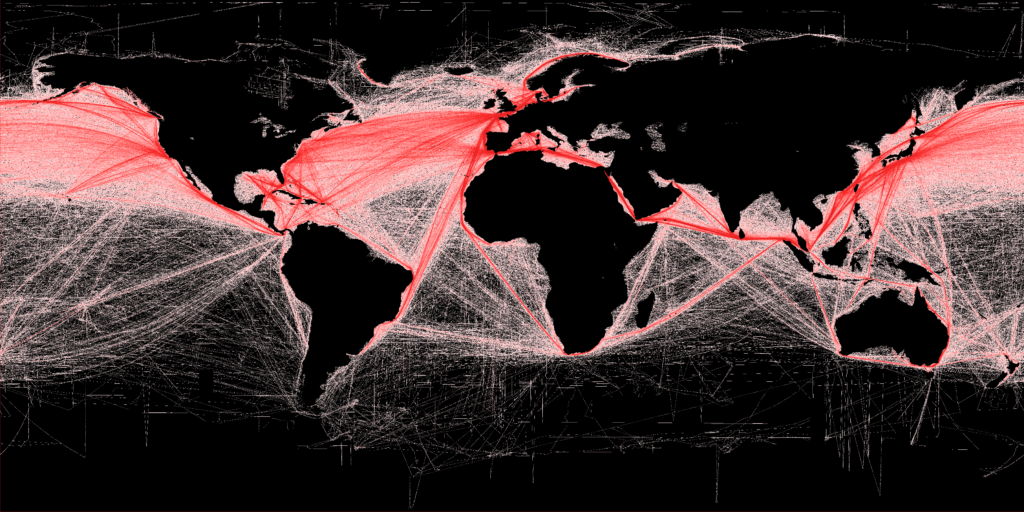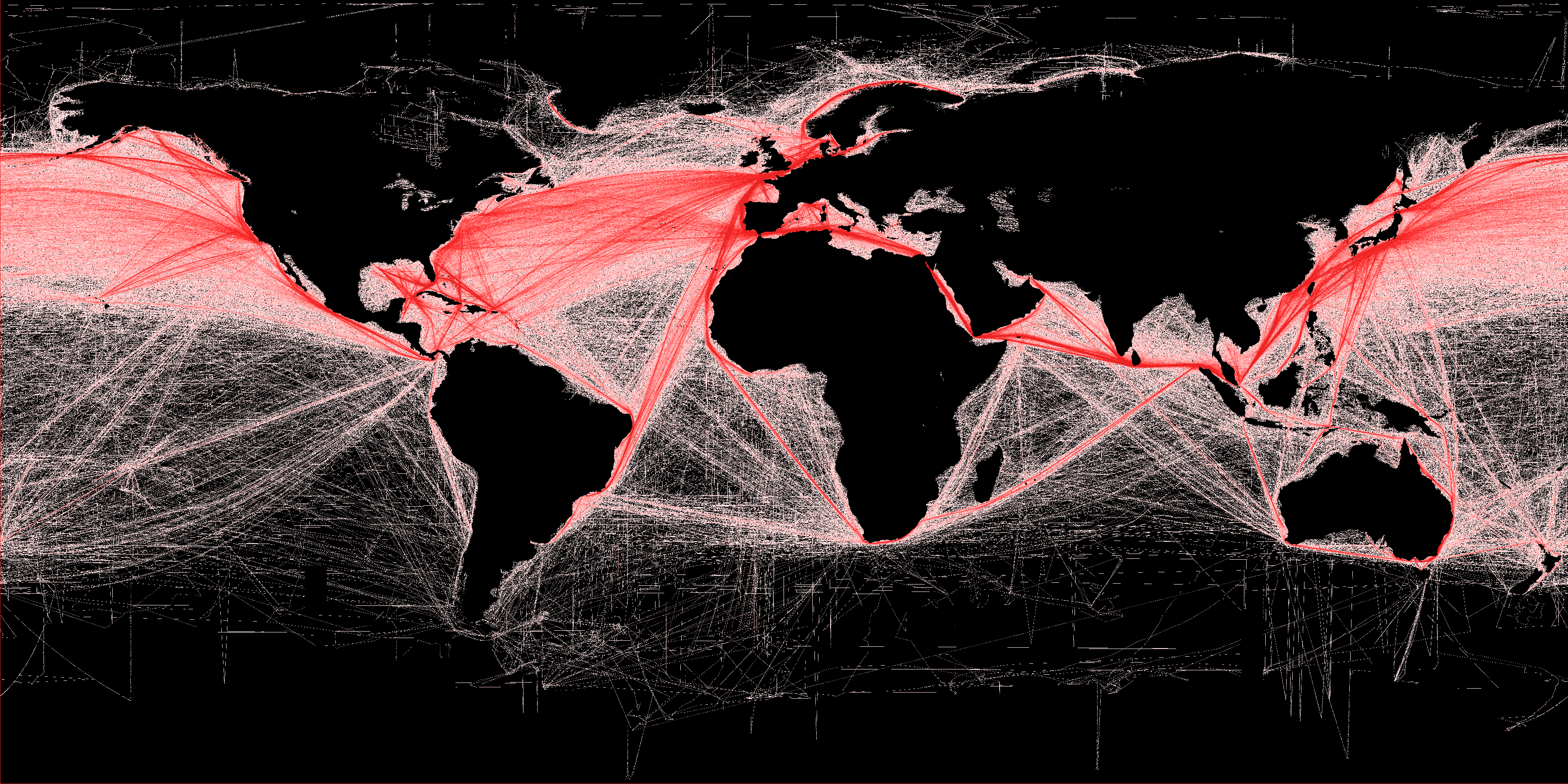
Credit: Grolltech
NEW SATELLITE DATA REVEALS WHOPPING BOOST IN SHIPPING
Maritime traffic on the world’s oceans has increased four-fold over the past 20 years, likely causing more water, air and noise pollution on the open seas, according to a new study quantifying global ship traffic.
The research used satellite data to estimate the number of vessels on the ocean every year between 1992 and 2012. The number of ships traversing the oceans grew by 60 percent between 1992 and 2002. Shipping traffic grew even faster during the second decade of the study, peaking at rate of increase of 10 percent per year in 2011.
Traffic went up in every ocean during the 20 years of the study, except off the coast of Somalia, where increasing piracy has almost completely halted commercial shipping since 2006. In the Indian Ocean, where the world’s busiest shipping lanes are located, ship traffic grew by more than 300 percent over the 20-year period, according to the research.
Ships powered by fossil fuels dump oil, fuel and waste into the water and pump exhaust into the air. Shipping is also a major source of noise pollution, which is increasingly considered potentially harmful to marine mammals, said Jean Tournadre, a geophysicist at Ifremer, the French Institute for the Exploitation of the Sea in Plouzane, and the study author.
“I found it quite worrisome that the ship traffic grew so much, even in very remote regions of the world,” Tournadre said, “especially when we know that they are the major source of pollution [on the open ocean].”
International trade and the sizes of merchant fleets have both enlarged rapidly over the past two decades, explaining the steep rise in ship traffic, the study reports. The new analysis has been accepted for publication in Geophysical Research Letters, a journal of the American Geophysical Union.
Burgeoning ship traffic has increased the amount of pollution in the atmosphere, particularly above the Sri Lanka-Sumatra-China shipping lane, where the study notes a 50 percent increase in nitrogen dioxide, a common air pollutant, over the 20-year period.
Tournadre said he hopes the new study will increase scientists’ understanding of how human activities are affecting marine ecosystems and improve models of atmospheric pollution in the open ocean.
The new dataset will provide scientists with invaluable insights into the patterns of ship traffic and the traffic’s effect on the environment, said Batuhan Osmanoglu, a radar systems engineer at NASA’s Goddard Space Flight Center in Green Belt, Md., who was not involved in the study.
“The nice thing about this study is that they have a unique dataset, that maybe we’re looking at for the first time,” he said. “Whenever you have a unique dataset you can quite easily learn something new.”
The Latest on: Worldwide ship traffic
[google_news title=”” keyword=”Worldwide ship traffic” num_posts=”10″ blurb_length=”0″ show_thumb=”left”]
via Google News
The Latest on: Worldwide ship traffic
- The ship that brought down a Baltimore bridge to be removed from collapse site in the coming weekson May 1, 2024 at 4:20 am
Thousands of longshoremen, truckers and small business owners have seen their jobs impacted by the collapse, making reopening the port a priority.
- Authorities reveal what next for the ship that brought down Baltimore bridgeon May 1, 2024 at 12:29 am
Authorities reveal what next for the ship that brought down Baltimore bridge - The ship has been stationary amid the wreckage since the March 26 collapse ...
- Exposure to traffic noise disrupts bird developmenton April 30, 2024 at 5:10 pm
The findings indicate that exposure to traffic noise - common in urban settings - directly affects the growth and fitness of birds ...
- Ship that brought down Baltimore bridge to be removed in the coming weekson April 30, 2024 at 11:38 am
BALTIMORE — At the site of the Francis Scott Key Bridge collapse, crews plan to refloat and remove the grounded Dali container ship within roughly the next 10 days, allowing more maritime traffic to ...
- Princess Cruises Changes World Cruise Itinerarieson April 30, 2024 at 8:42 am
In response to uncertainties in the Red Sea, Princess Cruises announced significant changes to its upcoming global voyages.
- Cruise ships in Miami used to look like that? How we traveled in the 1970s and ’80son April 30, 2024 at 5:33 am
In those early days of the late 1960s and into the 1970s and ‘80s, ships started arriving to their new expanded home. They were smaller than what we see today (along with the Miami skyline as a ...
- Many ships off Georgia, Carolinas exceed whale-protection speed limits, data showon April 30, 2024 at 2:27 am
Nearly half of commercial container and bulk vessels operating off the coasts of Georgia and the Carolinas are exceeding seasonal speed limits.
- 7 best car shipping companies of 2024on April 29, 2024 at 8:48 am
The best car shipping companies offer excellent customer service, warranties and pricing. Of the 36 we reviewed, these seven stand out.
- Gold watch found on body of Titanic's richest passenger is for saleon April 26, 2024 at 3:58 pm
A gold pocket watch recovered along with the body of John Jacob Astor, the richest passenger on the Titanic, is up for auction.
- Stranded ships exit Baltimore port via temporary channelon April 26, 2024 at 2:26 pm
Large ship traffic to and from the port, the busiest in the U.S. for auto shipments, has been severely restricted since the hulking Dali container ship lost power and smashed into the bridge on March ...
via Bing News










